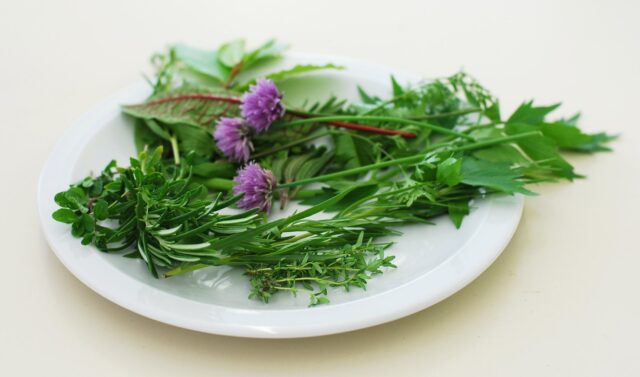Whether you’re an experienced gardener or just starting out, knowing which herbs can be planted together is essential for creating a thriving herb garden. In this detailed blog post, we’ll explore different types of herbs, their life cycles, and the art of companion planting.
Understanding Herb Types

Planting Herbs Together
Before we dive into companion planting, let’s get acquainted with the three main types of herbs:
- Annual Herbs:
- These herbs complete their life cycle within a single year. They grow from seeds, bloom, set their own seeds, and then gracefully exit the stage—all in one growing season.
- Some common annual herbs include:
- Basil: A fragrant herb that pairs well with tomatoes and other Mediterranean flavors.
- Borage: Known for its edible blue flowers and cucumber-like taste.
- Chamomile: Renowned for its calming properties and delicate white flowers.
- Cilantro/Coriander: Loved for its fresh, citrusy flavor.
- Dill: A feathery herb with a distinct anise-like taste.
- Fennel: Adds a sweet, licorice-like flavor to dishes.
- Lemon Balm: Offers a lemony aroma and mild flavor.
- Marjoram: A close relative of oregano, perfect for savory dishes.
- Stevia: A natural sweetener derived from its leaves.
- Biennial Herbs:
- Biennial herbs, such as lovage and parsley, follow a two-year life cycle. They germinate and grow vegetatively in the first season, go dormant over winter (especially in cold areas), and then mature and flower in the second growing season before gracefully bowing out.
- These herbs have the best flavor during their first year after seeding.
- Perennial Herbs:
- Perennial herbs are the evergreen stars of your herb garden. Once established, they return faithfully every growing season, only dying down during winter.
- Well-drained soil is crucial for perennial herbs. If you’re growing them in poorly drained areas, consider building raised beds.
- Some popular perennial herbs include:
- Rosemary: A fragrant herb with needle-like leaves.
- Thyme: Known for its earthy flavor and versatility.
- Sage: Adds warmth and depth to savory dishes.
- Mint: Refreshing and aromatic, but be cautious—it can be invasive!
- Oregano: A staple in Mediterranean cuisine.
- Lavender: Not just for fragrance; its flowers are edible too.
- Chives: Mild onion flavor, great for garnishing.
- Lemon Verbena: Intensely lemon-scented leaves.
- Tarragon: Delicate anise-like flavor.
- Catnip: Beloved by cats and humans alike.
- Dill: Yes, it’s both an annual and a perennial!
Companion Planting: The Art of Pairing Herbs
Companion planting involves strategically placing herbs and other plants together to enhance growth, deter pests, and improve flavors. Here are some herb companionship tips:
- Mediterranean Herbs:
- Rosemary, thyme, and oregano thrive together. Their aromatic leaves complement each other and create a delightful herb trio.
- Basil and parsley also play well with these Mediterranean herbs.
- Moisture-Loving Herbs:
- Mint, chives, and lemon verbena appreciate consistent moisture. Plant them near each other and keep the soil damp.
- Basil, Parsley, Chamomile, and Oregano:
- These herbs make excellent companions. They share similar growing conditions and enhance each other’s flavors.
- Tarragon, Catnip, and Dill:
- These herbs can coexist harmoniously. Tarragon adds a hint of anise, catnip attracts beneficial insects, and dill brings its unique flavor.
Conclusion
Now armed with knowledge about herb types and companion planting, you’re ready to create a harmonious herb garden. Experiment, observe, and enjoy the delightful symphony of flavors and fragrances that these herbs bring to your culinary adventures!
Frequently Asked Questions (FAQs) About Planting Herbs Together
- Q: Can I plant different types of herbs together in the same garden?
- A: Absolutely! Herbs that share similar growing conditions can be planted together. Consider companions like sage, thyme, rosemary, marjoram, lavender, and oregano.
- Q: Is it okay to grow mint alongside other herbs?
- A: Mint is a bit of a rebel it tends to take over. It’s best to avoid planting mint with other herbs due to its invasive properties.
- Q: Which herbs make good neighbors for basil?
- A: Basil pairs well with tomatoes, peppers, purslane, and lettuce. Oregano and parsley are also great companions for basil in the garden.
- Q: What’s the secret to growing flavorful bay leaves?
- A: Plant bay (Laurus nobilis) alongside beans. It thrives when grown with rosemary, sage, thyme, and parsley. Bay leaves add rich flavor to soups and stews.
- Q: How can I enhance my vegetable garden with chives?
- A: Chives, with their oniony yet subtle flavor, thrive when planted near carrots, tomatoes, and sunflowers. They pair well with dill, marjoram, parsley, and tarragon.
- Q: What’s the deal with dill?
- A: Dill’s fresh anise-like flavor makes it a great companion for tomatoes, peppers, eggplants, and cabbages. It also works well with chives, lemon balm, lemon thyme, and lovage.
- Q: Which herbs can I grow as perennial companions?
- A: Consider basil, cilantro, lavender, lemon thyme, lemon verbena, marjoram, oregano, parsley, rosemary, sage, tarragon, and thyme for a harmonious herb garden.
- Q: Can I mix different herb types in a container garden?
- A: Yes! Sage, thyme, rosemary, marjoram, and lavender can happily coexist. Just ensure they have similar environmental needs.
- Q: What’s the secret to a beautiful herb wreath?
- A: Combine fragrant herbs like basil, rosemary, and thyme. Their aromatic leaves create stunning wreaths for your kitchen or home.
- Q: How do I maximize growth and flavor in my herb garden?
- A: Experiment with companion planting! From basil and chives to thyme and rosemary, thoughtful pairings lead to a productive and delightful herb garden.




